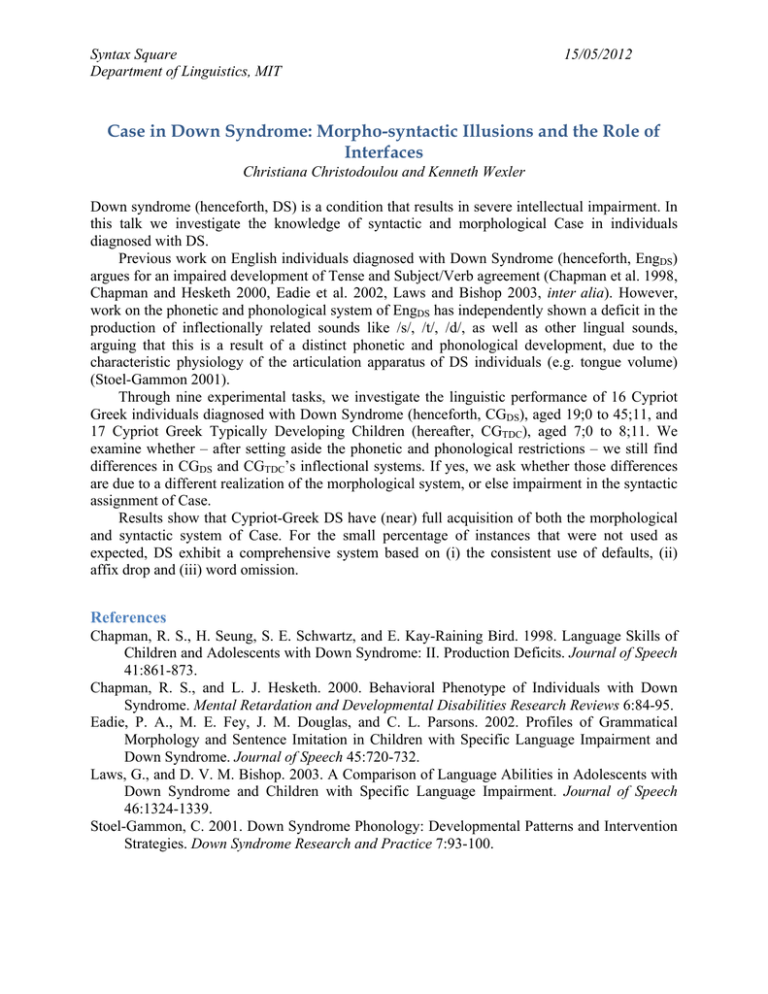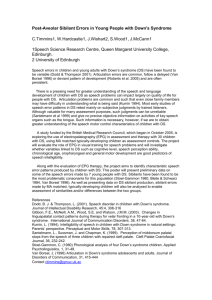Case in Down Syndrome: Morpho-syntactic Illusions and the Role of Interfaces
advertisement

Syntax Square Department of Linguistics, MIT 15/05/2012 Case in Down Syndrome: Morpho-syntactic Illusions and the Role of Interfaces Christiana Christodoulou and Kenneth Wexler Down syndrome (henceforth, DS) is a condition that results in severe intellectual impairment. In this talk we investigate the knowledge of syntactic and morphological Case in individuals diagnosed with DS. Previous work on English individuals diagnosed with Down Syndrome (henceforth, EngDS) argues for an impaired development of Tense and Subject/Verb agreement (Chapman et al. 1998, Chapman and Hesketh 2000, Eadie et al. 2002, Laws and Bishop 2003, inter alia). However, work on the phonetic and phonological system of EngDS has independently shown a deficit in the production of inflectionally related sounds like /s/, /t/, /d/, as well as other lingual sounds, arguing that this is a result of a distinct phonetic and phonological development, due to the characteristic physiology of the articulation apparatus of DS individuals (e.g. tongue volume) (Stoel-Gammon 2001). Through nine experimental tasks, we investigate the linguistic performance of 16 Cypriot Greek individuals diagnosed with Down Syndrome (henceforth, CGDS), aged 19;0 to 45;11, and 17 Cypriot Greek Typically Developing Children (hereafter, CGTDC), aged 7;0 to 8;11. We examine whether – after setting aside the phonetic and phonological restrictions – we still find differences in CGDS and CGTDC’s inflectional systems. If yes, we ask whether those differences are due to a different realization of the morphological system, or else impairment in the syntactic assignment of Case. Results show that Cypriot-Greek DS have (near) full acquisition of both the morphological and syntactic system of Case. For the small percentage of instances that were not used as expected, DS exhibit a comprehensive system based on (i) the consistent use of defaults, (ii) affix drop and (iii) word omission. References Chapman, R. S., H. Seung, S. E. Schwartz, and E. Kay-Raining Bird. 1998. Language Skills of Children and Adolescents with Down Syndrome: II. Production Deficits. Journal of Speech 41:861-873. Chapman, R. S., and L. J. Hesketh. 2000. Behavioral Phenotype of Individuals with Down Syndrome. Mental Retardation and Developmental Disabilities Research Reviews 6:84-95. Eadie, P. A., M. E. Fey, J. M. Douglas, and C. L. Parsons. 2002. Profiles of Grammatical Morphology and Sentence Imitation in Children with Specific Language Impairment and Down Syndrome. Journal of Speech 45:720-732. Laws, G., and D. V. M. Bishop. 2003. A Comparison of Language Abilities in Adolescents with Down Syndrome and Children with Specific Language Impairment. Journal of Speech 46:1324-1339. Stoel-Gammon, C. 2001. Down Syndrome Phonology: Developmental Patterns and Intervention Strategies. Down Syndrome Research and Practice 7:93-100.




